#EmberJS Web Development
Explore tagged Tumblr posts
Text
Top Benefits of Hiring Dedicated Ember.js Developers

Ember. js stays popular as one of the most widely used frameworks for creating complex web applications and remains a preferred choice because of its well-structured structure and reliable characteristics. Despite the fields identified earlier as appropriate for development using Ember, it is recommended that before starting the next web project with Ember.js, one should contain the following aspects. Choosing dedicate Ember.js developers can provide a substantial increase in result. Namely the following can be outlined as advantages of cooperating with dedicated Ember. js developers and explain how they can skyrocket your project.
1. Expertise and Specialization
Dedicated Ember. js developers acquire some specific skills and experience in using the framework to the maximum effect possible. They should be conversant with Ember. js standards, coding practices, and effective ways of programming. This knowledge allows them to design solutions that can grow as necessary; that can tune performance and be as close to Ember. js principles that will make your application solid as well as maintainable.
2. Focus and Commitment
Unlike, Emberjs developer on contract and Remote ember.js developer working on several projects at the same time,Dedicated Ember. js developers are employed exclusively on your project, so their work is made up of your project alone. It complements their hard work and dedication with steady improvement, precise work, as well as the early identification of potential issues. This dedicated approach enables one to meet all the set deadlines effectively and for your project not to be swayed off course by other tasks.
3. Seamless Integration and Collaboration
The Remote ember. js developer easily merge with your team and or project setting. They are on board with your company objectives, comprehend your project needs, and integrate into your ways of working and sharing information. It encourages the process of collaboration as well as brings in transparency for all the project stakeholders and amongst the team members, which leads to a synchronized process of development.
4. Long-term Support and Continuity
Establishing a long-term partnership with dedicated Ember.js developers guarantees your project's stability and continuous support. They get to know the architecture of your program inside and out, comprehend how it changes over time, and are in a good position to offer timely updates and preventive maintenanc e. This continuity reduces disturbances, enhances stability, and enables quick reactions to new requirements or difficulties.
5. Cost Efficiency and Value
While the initial investment in dedicated developers may seem higher, it offers long-term cost efficiency and value. You eliminate recruitment costs, overhead expenses associated with onboarding, and the risks of turnover. Moreover, dedicated developers often streamline development processes, leading to faster time-to-market and improved return on investment (ROI) for your application.
How to Hire Dedicated Ember.js Developers
To ensure a successful hiring process for dedicated Ember.js developers, consider the following steps:
Define Your Requirements: Be very specific about your project objective, specifications and the skills that you need in Ember. js development.
Search Strategically: There is dedicated job boards and professional networking sites aimed at identifying people with Ember. js work experience. js.
Evaluate Skills and Experience: Review candidates’ portfolios, conduct technical assessments, and schedule interviews to assess their proficiency and compatibility with your project.
Cultural Fit: Determine a person's level of ability in communication and teamwork as well as their cultural fit for the team.
Trial Period: Trial period or short term contract can be effective if there is a necessity for a long term cooperation in order in order to assess the effectiveness of a particular service as well as a compatibility of both, parties.
Conclusion
Hiring dedicated Ember.js developer can be a great benefit when launching high-quality, highly scalable web applications that correlate with business goals. They focus on the particular service they offer, they are dedicated to your project and its success, and blend into your group’s structure to guarantee effective development cycles and future support. In the course of introducing a new application or improving the existing one, it is profitable to allocate separate Ember. Js developers can help you advance so fast in your developments and get the best services ever.
If you are ready to take your Web Development to the next level with dedicated Ember. js developers, start your search today and get the most out of this extremely powerful tool.
Remember, the right Ember. javascript developers are capable of translating your ideas into a tangible outcome and with their experience in the field, come up with unique web solutions that will meet your demands while at the same time establishment sustainable solutions.
0 notes
Text
In an already volatile IT world, it could all change in a moment, particularly when it comes to cybersecurity. And since PHP is the most powerful server-side language and the backbone for almost every website, it demands the adoption of best security practices. Therefore, PHP security shouldn’t be neglected at any cost. To prevent your PHP website from such attacks and vulnerabilities, we’ve compiled the top seven tips to help keep your website safe and secure online. Let’s have a look! 1. Keep Your Software Updated Keeping your software updated is a foundational practice of keeping your site safe and secure. It applies to both the server operating system and any software that you may be running on websites such as CMS or forums. Unfortunately, hackers can quickly attempt to abuse any vulnerabilities found in website security. If you are using third-party software on your websites, such as a CMS or forum, you should quickly apply any security patches. Most vendors have a mailing list or RSS feed detailing website security issues. In addition, there are many other CMSes such as WordPress and Umbraco that notify you of available system updates when you log in. Many developers use Composer, npm, and RubyGems to evaluate their software dependencies and security vulnerabilities. Unfortunately, if you do not pay enough attention to this area, your PHP website can be easily caught out by hackers. Ensure to keep your dependencies up to date and use tools like Gemnasium to get automatic notifications when there is a vulnerability in one of your components. 2. Beware of Error Messages Most importantly, you must know how much information you should give regarding error messages. You only need to provide only minimal errors to your users. This way, you can ensure that they don’t leak any sensitive information on your server, such as database passwords, API keys, etc. Also, pay attention not to provide full exception details so as not to invite complex attacks like SQL injection. You should keep all the detailed errors in your server logs and show your users only the information they need. 3. Check Your Passwords Many web admins often fail to use strong passwords despite this practice being considered an essential security requirement. Here, we’ve compiled a list of some effective password practices to prevent security breaches: The passwords can be more protected by storing the same encrypted values. The quality hashing algorithms can be used for this. The standard practice is to use at least eight-character passwords, including a number and a blend of uppercase and lowercase letters. If the password is still being accessed or guessed, you can use hashed passwords as they can’t be decrypted. 4. Protect Against XSS Attacks Do you know that XSS (Cross-site scripting) is one of the most common methods of hacking a website? It is done by injecting malicious JavaScript code into the web pages, which can permanently harm the website. In general, programs can run on the browsers used by the users and interfere with the user experience. XSS mainly happens through malicious program links posted through comments and other kinds of user-generated content. Using frameworks like AngularJS and EmberJS equipped with protection from cross-site scripting is a great way to prevent such attacks. In addition, it would help prevent the mixing of client-side and server-side rendering, reducing malicious JavaScript injections. There is another effective way to prevent XSS attacks; CSP (Content Security Policy) works like a server-side header to direct the browser about the JavaScript execution on any given page. In addition, it can be a potent tool to prevent cross-site scripting attacks. 5. Get Website Security Tools It’s time to test your website security when you think you have done all you can. The most effective way of doing this is using some website security tools, often referred to as penetration tests or pen-testing. There are several commercial and free products to assist you with this.
They work on a similar basis to script hackers. In this, they test all known exploits and attempts to compromise your site using SQL Injection. Check Out Some Free Tools Which are Worth Looking Into Xenotix XSS Exploit Framework: It is a tool based on OWASP (Open Web Application Security Project), which includes many XSS attack examples. This can be run to quickly confirm whether the site’s inputs are vulnerable in Chrome, Firefox, and IE. SecurityHeaders.io: This free online check tool allows free security and configuration checks for your website. OpenVas: It’s a free and open-source security testing tool with many advanced features. This tool is claimed to be the most advanced open source security scanner. It is suitable for testing known vulnerabilities and recently scanned over 25,000. Netsparker: This tool is available in both free and trial versions. It is ideal for testing XSS attacks as well as SQL injection. 6. Use HTTPS This is a protocol that is used to provide security over the Internet. HTTPS ensures what users expect in terms of security and that nobody else can change the content they see in transit. If users want anything private, it’s highly advisable to use only HTTPS to deliver it. For example, the credit card and other login pages have login forms. A login form often sets a cookie, which is sent with every other request to the website that a logged-in user makes. And it is used to authenticate those requests. An attacker might steal this sensitive information and take over the user’s login session. You only need to use HTTPS for your entire site to prevent attacks. It is now no longer as expensive as it was earlier. Let’s Encrypt offers free and automated certificates, which you’ll need to enable HTTPS. Also, there are existing community tools available for a wide range of common platforms and frameworks, which are automatically set up. Moreover, according to the report, Google will enhance those websites in search engine rankings that are equipped with HTTPS. This way, SEO benefits will also be provided to them. If you are already using HTTPS, then go further and set up HTTP Strict Transport Security (HSTS), an easy header that you can add to your server responses to disable insecure HTTP for your entire domain. 7. Input Validation Gazillions of PHP websites still depend on client-side programs for validating inputs. The client-side programs mean JavaScript-based input validation programs, which can easily be bypassed. You can also use rather server-side input validation programs. Final Thoughts When security threats have become more sophisticated than ever before, it’s not a good idea to depend on outdated security practices. Now you have excellent and comprehensive security strategies to prevent your PHP website from hacking. Furthermore, hiring mobile app developers for professional and advanced support is highly advisable.
0 notes
Text
0 notes
Text
EmberJs Web App Development Services
Pattem Digital offers top-notch Ember.js web app development services that are designed to create dynamic, interactive, and user-friendly online applications. Using the power of the Ember.js JavaScript framework, our talented team of engineers crafts solutions that are scalable and dependable, tailored to your specific business needs. Depending on your needs, we could offer you a complex web platform or a straightforward one-page application.
0 notes
Link
0 notes
Text
What Differences to Find in Between AngularJS Vs EmberJS?
The digital business territory has become a vast area comprising of millions of enterprises featuring to be the best one. It results in pioneer modifications and innovations in web application development meeting varied requirements of businesses. Out of different available choices, Single Page Application (SPA) is something ideally preferred by various organizations. Just like Gmail, Twitter, Linkedin, Yahoo, Youtube, Live Nation, and other single-page application platforms. Several organizations move towards creating a well-defined SPA while offering their leading products and services.
Read more at – What Differences to Find in Between AngularJS Vs EmberJS?
#web application development#angularjs vs emberjs#angularjs development#angularjs development services#angularjs development company#hire angularjs developer
0 notes
Photo
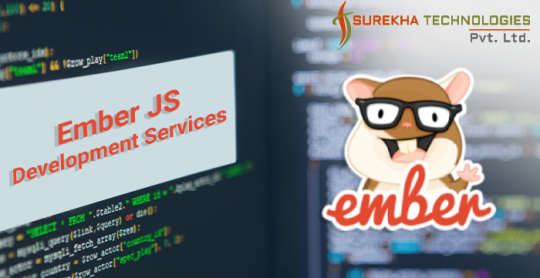
Ember Js Web and Application Development Company in India
Ember is a client-side Javascript Framework managed by the fast-growing stable community and used to build robust and productive applications.
Surekha Technologies, provides end-to-end offshore Ember JS web application development services, including requirement gathering, architecture, design, development, testing, deployment, maintenance, and support.
You can also hire our skilled Ember developers who can work remotely or onsite. http://bit.ly/2I27BdI
0 notes
Text
Noteworthy PHP Development Tools that a PHP Developer should know in 2021!
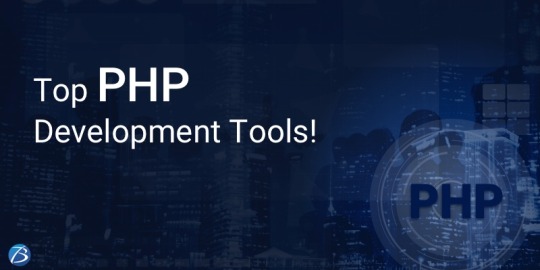
Hypertext Preprocessor, commonly known as PHP, happens to be one of the most widely used server-side scripting languages for developing web applications and websites. Renowned names like Facebook and WordPress are powered by PHP. The reasons for its popularity can be attributed to the following goodies PHP offers:
Open-source and easy-to-use
Comprehensive documentation
Multiple ready-to-use scripts
Strong community support
Well-supported frameworks
However, to leverage this technology to the fullest and simplify tasks, PHP developers utilize certain tools that enhance programming efficiency and minimize development errors. PHP development tools provide a conducive IDE (Integrated Development Environment) that enhances the productivity of PHP Website Development.
The market currently is overflooded with PHP tools. Therefore, it becomes immensely difficult for a PHP App Development Company to pick the perfect set of tools that will fulfill their project needs. This blog enlists the best PHP development tools along with their offerings. A quick read will help you to choose the most befitting tool for your PHP development project.
Top PHP Development tools
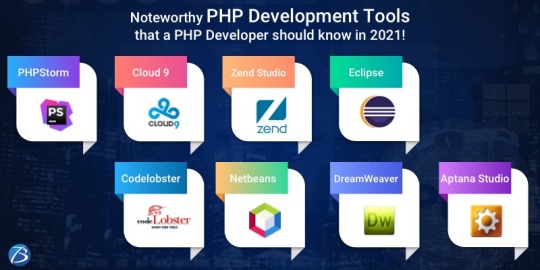
PHPStorm
PHPStorm, created and promoted by JetBrains, is one of the most standard IDEs for PHP developers. It is lightweight, smooth, and speedy. This tool works easily with popular PHP frameworks like Laravel, Symfony, Zend Framework, CakePHP, Yii, etc. as well as with contemporary Content Management Systems like WordPress, Drupal, and Magento. Besides PHP, this tool supports JavaScript, C, C#, Visual Basic and C++ languages; and platforms such as Linux, Windows, and Mac OS X. This enterprise-grade IDE charges a license price for specialized developers, but is offered for free to students and teachers so that they can start open-source projects. Tech giants like Wikipedia, Yahoo, Cisco, Salesforce, and Expedia possess PHPStorm IDE licenses.
Features:
Code-rearranging, code completion, zero-configuration, and debugging
Support for Native ZenCoding and extension with numerous other handy plugins such as the VimEditor.
Functions:
Provides live editing support for the leading front-end technologies like JavaScript, HTML5, CSS, TypeScript, Sass, CoffeeScript, Stylus, Less, etc.
It supports code refactoring, debugging, and unit testing
Enables PHP developers to integrate with version control systems, databases, remote deployment, composer, vagrant, rest clients, command-line tools, etc.
Coming to debugging, PHPStorm works with Xdebug and Zend Debugger locally as well as remotely.
Cloud 9
This open-source cloud IDE offers a development eco-system for PHP and numerous other programming languages like HTML5, JavaScript, C++, C, Python, etc. It supports platforms like Mac OS, Solaris, Linux, etc.
Features:
Code reformatting, real-time language analysis, and tabbed file management.
Availability of a wide range of themes
In-built image editor for cropping, rotating, and resizing images
An in-built terminal that allows one to view the command output from the server.
Integrated debugger for setting a breakpoint
Adjustable panels via drag and drop function
Support for keyboard shortcuts resulting in easy access
Functions:
With Cloud 9, one can write, run and debug the code using any browser. Developers can work from any location using a machine connected to the internet.
It facilitates the creation of serverless apps, allowing the tasks of defining resources, executing serverless applications, and remote debugging.
Its ability to pair programs and track all real-time inputs; enables one to share their development eco-system with peers.
Zend Studio
This commercial PHP IDE supports most of the latest PHP versions, specifically PHP 7, and platforms like Linux, Windows, and OS X. This tool boasts of an instinctive UI and provides most of the latest functionalities that are needed to quicken PHP web development. Zend Studio is being used by high-profile firms like BNP Paribas Credit Suisse, DHL, and Agilent Technologies.
Features:
Support for PHP 7 express migration and effortless integration with the Zend server
A sharp code editor supporting JavaScript, PHP, CSS, and HTML
Speedier performance while indexing, validating, and searching for the PHP code
Support for Git Flow, Docker, and the Eclipse plugin environment
Integration with Z-Ray
Debugging with Zend Debugger and Xdebug
Deployment sustenance including cloud support for Microsoft Azure and Amazon AWS.
Functions:
Enables developers to effortlessly organize the PHP app on more than one server.
Provides developers the flexibility to write and debug the code without having to spare additional effort or time for these tasks.
Provides support for mobile app development at the peak of live PHP applications and server system backend, for simplifying the task of harmonizing the current websites and web apps with mobile-based applications.
Eclipse
Eclipse is a cross-platform PHP editor and one of the top PHP development tools. It is a perfect pick for large-scale PHP projects. It supports multiple languages – C, C++, Ada, ABAP, COBOL, Haskell, Fortran, JavaScript, D, Julia, Java, NATURAL, Ruby, Python, Scheme, Groovy, Erlang, Clojure, Prolong, Lasso, Scala, etc. - and platforms like Linux, Windows, Solaris, and Mac OS.
Features:
It provides one with a ready-made code template and automatically validates the syntax.
It supports code refactoring – enhancing the code’s internal structure.
It enables remote project management
Functions:
Allows one to choose from a wide range of plugins, easing out the tasks of developing and simplifying the complex PHP code.
Helps in customizing and extending the IDE for fulfilling project requirements.
Supports GUI as well as non-GUI applications.
Codelobster
Codelobster is an Integrated Development Environment that eases out and modernizes the PHP development processes. Its users do not need to worry about remembering the names of functions, attributes, tags, and arguments; as these are enabled through auto-complete functions. It supports languages like PHP, JavaScript, HTML, and CSS and platforms such as Windows, Linux, Ubuntu, Fedora, Mac OS, Linux, and Mint. Additionally, it offers exceptional plugins that enable it to function smoothly with myriad technologies like Drupal, Joomla, Twig, JQuery, CodeIgniter, Symfony, Node.js, VueJS, AngularJS, Laravel, Magento, BackboneJS, CakePHP, EmberJS, Phalcon, and Yii.
Offerings:
It is an internal, free PHP debugger that enables validating the code locally.
It auto-detects the existing server settings followed by configuring the related files and allowing one to utilize the debugger.
It has the ability to highlight pairs of square brackets and helps in organizing files into the project.
This tool displays a popup list comprising variables and constants.
It allows one to hide code blocks that are presently not being used and to collapse the code for viewing it in detail.
Netbeans
Netbeans, packed with a rich set of features is quite popular in the realm of PHP Development Services. It supports several languages like English, Russian, Japanese, Portuguese, Brazilian, and simplified Chinese. Its recent version is lightweight and speedier, and specifically facilitates building PHP-based Web Applications with the most recent PHP versions. This tool is apt for large-scale web app development projects and works with most trending PHP frameworks such as Symfony2, Zend, FuelPHP, CakePHP, Smarty, and WordPress CMS. It supports PHP, HTML5, C, C++, and JavaScript languages and Windows, Linux, MacOS and Solaris platforms.
Features:
Getter and setter generation, quick fixes, code templates, hints, and refactoring.
Code folding and formatting; rectangular selection
Smart code completion and try/catch code completion
Syntax highlighter
DreamWeaver
This popular tool assists one in creating, publishing, and managing websites. A website developed using DreamWeaver can be deployed to any web server.
Offerings:
Ability to create dynamic websites that fits the screen sizes of different devices
Availability of ready-to-use layouts for website development and a built-in HTML validator for code validation.
Workspace customization capabilities
Aptana Studio
Aptana Studio is an open-source PHP development tool used to integrate with multiple client-side and server-side web technologies like PHP, CSS3, Python, RoR, HTML5, Ruby, etc. It is a high-performing and productive PHP IDE.
Features:
Supports the most recent HTML5 specifications
Collaborates with peers using actions like pull, push and merge
IDE customization and Git integration capabilities
The ability to set breakpoints, inspecting variables, and controlling the execution
Functions:
Eases out PHP app development by supporting the debuggers and CLI
Enables programmers to develop and test PHP apps within a single environment
Leverages the flexibilities of Eclipse and also possesses detailed information on the range of support for each element of the popular browsers.
Final Verdict:
I hope this blog has given you clear visibility of the popular PHP tools used for web development and will guide you through selecting the right set of tools for your upcoming project.
To know more about our other core technologies, refer to links below:
React Native App Development Company
Angular App Development Company
ROR App Development
#Php developers#PHP web Development Company#PHP Development Service#PHP based Web Application#PHP Website Development Services#PHP frameworks
1 note
·
View note
Text
List of Top JavaScript Frameworks 2020 For Front End Development
JavaScript is defining the future of the tech world with its wide genre of competent frameworks, which are capable of accelerating the development of applications in many ways. How to choose a certain framework in JavaScript is based on the company’s goals, project requirements and how certain frameworks can be used in different scenarios.
JavaScript, one of the most surreal and beautiful programming languages, enwrapped by the intriguing fact that even though it is named “Java” Script, it doesn’t have any association with Java. In mid-1995, when JavaScript came into existence it was disguised as the name Mocha and later it was named as “LiveScript” and when Netscape and Sun did a license agreement it was finally renamed to “JavaScript”. Nobody had even imagined in its initial form that it would be such a revolutionary programming language and would be entitled as one of the major languages to learn. The world is pacing fast with the ever-changing technology and programming languages being the pillar of technology. JavaScript is surely defining the future with its compelling and competent frameworks.
What are the Frameworks?
In general, a framework is a prototype or conceptual structure intended to serve as a support or guide for the building of something that expands the structure into something useful. According to Wikipedia ” A software framework is an abstraction in which software providing generic functionality can be selectively changed by additional user-written code, thus providing application-specific software.”
JavaScript web frameworks are cheat codes for quick web application development. They serve as a skeletal frame for single page application development and allows developers to worry less about code structure or maintenance and help them in focusing more on the creation of complex interface elements and expand opportunities of JS and plain HTML.
So, Which frameworks of JavaScript are most popular and why?
Below is the list of a few Javascript frameworks:
1. AngularJS- AngularJS is an open-source framework used in frontend and is maintained by Google. It is mainly used to subside and sort the problems encountered while creating single-page applications usually have, as it simplifies both development and testing of such application by providing a framework for client-side model view controller (MVC) and model view-view model (MVVM) architectures. For now, it is known to be the most used JavaScript framework for single-page applications and have the largest community of developers.
2. ReactJS- ReactJS camouflage itself to be JS framework but it is more of an open-source JS library, which has huge names like Facebook and Instagram behind it. React was built by a software engineer at Facebook. In 2011, it was first deployed on Facebook’s newsfeed and later on Instagram in 2012. React Js emerges in an ecosystem of complete frameworks, but it’s just the view. In MVC(Mobile-View-Controller) pattern, React.js acts as “V” and can be smoothly integrated with any architecture.
A fully functional dynamic application can’t be built with React alone. Recently, On April 18th 2017, Facebook announced a new core algorithm of React framework library for building user interface named React Fiber, which is said to be the foundation for future development and improvement of ReactJS.
3. Ember JS- A few years back, in 2015, EmberJs was considered to be the best framework leaving React and AngularJS behind. It does two-way data binding as same as AngularJS keeping both view and model in sync for all the time. Emberjs is commonly used for complex feature-rich web applications and website. LinkedIn, Netflix, Chipotle, Blue Apron, Nordstrom are one of the few of the top names that have incorporated EmberJS.
What works in its favour is that it is easy to learn and have many tutorials online which helps to learn it with ease.
4. Vue.Js- Vue.js is considered to be one of the best solutions for cross-platform development. The development of Vue.Js is considered by taking the best qualities from Angular, React and Ember such as Vue.js offers two-way data binding (same as in AngularJS), server-side rendering (like in Angular2 and ReactJS), Vue-CLI (backbone tool for quick start) and optional JSX support. and all the altering flaws in prior three.
5. MeteorJS- MeteorJS is a free and open-source framework, which is well-equipped with tons of features for back-end development, front-end rendering, DB(database) management and business logic. Being a full-stack platform, it has the quality that its name suggests which is being fast. If you’re looking to rapidly develop smaller, reactive applications on the Node.js platform, Meteor is definitely an excellent choice.
Due to its modular structure, all the packages and libraries can be used at a high pace. In terms of performance, all the changes in the database are transmitted to the UI in the shortest time possible and in conversely with no evident time losses caused by different languages or server response time.
The consideration of a JavaScript framework is based on the company’s goals, project requirements and how certain frameworks can be used in certain scenarios. JavaScript is portraying the whole new depiction of the future of technology as it backs the prompt development and prototyping.
These frameworks and libraries have already reshaped the way how JS collaborates with HTML and CSS to compile views both in browsers and now even on native platforms.
#java script framework#javascript framework development#javascript development 2020#website development company
2 notes
·
View notes
Photo

Top 7 Reasons Why ReactJS is Best For Web Application Development?
A majority of developers preferred to develop web apps on JavaScript frameworks. There are various JavaScript frameworks utilize in web app development and design. Some of the prevailing ones include EmberJS, AngularJS, NodeJS, VueJS, MeteorJS, and ReactJS development.
Among these Hire ReactJS developer for web apps development and gaining much popularity. The benefits of this framework have affected developers to move web apps to ReactJS.
For More info visit : https://hireasp.net/
Contact Us: [email protected]
#Hireasp.net#Hire ASP.Net Developers#hire react js developers#hire angularjs developers#.Net Web application development
1 note
·
View note
Link

OnGraph provides Ember.JS expert solutions that meet the client's unique business requirements. We are known in the industry for delivering best-in-class solutions. we have a team of professional Web & Mobile app developers, who have rich industry experience in developing applications using Ember.JS 2.16 or 2.17 versions.
#EmberjsDevelopmentServices#BestEmberJSDevelopmentCompany#EmberJSDevelopmentCompanies#Emberjsoutsourcingservices
3 notes
·
View notes
Text
𝐓𝐨𝐩 𝐫𝐚𝐭𝐞𝐝 𝐟𝐫𝐨𝐧𝐭 𝐞𝐧𝐝 𝐟𝐫𝐚𝐦𝐞𝐰𝐨𝐫𝐤𝐬 𝐟𝐨𝐫 𝐰𝐞𝐛 𝐝𝐞𝐯𝐞𝐥𝐨𝐩𝐦𝐞𝐧𝐭
The building blocks of early software development are frontend frameworks. However, many options are available when it comes to creating visually stunning apps with excellent user experiences. For your interest, we have created a list of the best frontend frameworks for 2023. Let's examine them!
𝟏. 𝐑𝐞𝐚𝐜𝐭
React was developed at Facebook to address issues with code maintainability brought on by the continual addition of features to the app. It is one of the simple frameworks to learn. Thanks to its virtual Document Object Model, React is now an open-source framework that stands out for the incredible features it offers (DOM).
𝟐. 𝐀𝐧𝐠𝐮𝐥𝐚𝐫
Angular differs from React due to its two-way data-binding functionality. Accordingly, any modifications made to the model are immediately reflected in the display, and vice versa.
𝟑. 𝐕𝐮𝐞𝐣𝐬
Vue is adaptable and helps you with a range of activities. In addition to creating online, mobile, and progressive web applications, it can easily manage simple and complex tasks. Visual DOM and component-based are two advantages that make it more compact.
𝟒. 𝐣𝐐𝐮𝐞𝐫𝐲
One of the first frontend frameworks was jQuery. Its relevance, even in the modern tech world, despite its launch date, is what makes it unique. In addition to providing simplicity and convenience.
𝟓. 𝐄𝐦𝐛𝐞𝐫𝐣𝐬
Emberjs, created in 2011, is component-based and provides two-way data binding, much like Angular. It is made to easily meet the escalating demands of contemporary technology.
𝟔. 𝐁𝐚𝐜𝐤𝐛𝐨𝐧𝐞𝐣𝐬
One of the simplest frameworks out there, Backbonejs, makes it simple to develop single-page applications. It uses a framework built on the MVC architecture.
𝟕. 𝐒𝐞𝐦𝐚𝐧𝐭𝐢𝐜-𝐔𝐈
Despite being relatively new to the world of frameworks, Semantic-UI is already well on its way to being one of the frontend frameworks most extensively used globally. It is distinguished by its simple functionality, usefulness, and intuitive user interface.
𝟖. 𝐅𝐨𝐮𝐧𝐝𝐚𝐭𝐢𝐨𝐧
It was created by Zurb and is only appropriate for the enterprise-level creation of responsive and agile websites. It includes fast mobile rendering capabilities, GPU acceleration for incredibly smooth animations.
𝟗. 𝐒𝐯𝐞𝐥𝐭𝐞
The most recent frontend framework is called Svelte. In contrast to frameworks like React and Vue, the framework has made a difference by moving the work into a compilation phase rather than the browser.
𝟏𝟎. 𝐏𝐫𝐞𝐚𝐜𝐭
Because Preact is compatible with and resembles React, developers, don't have to learn it from scratch. Because of its thin compatibility layer, developers can use pre-existing React packages.
𝐅𝐨𝐫 𝐦𝐨𝐫𝐞 𝐢𝐧𝐟𝐨𝐫𝐦𝐚𝐭𝐢𝐨𝐧: https://www.qservicesit.com/
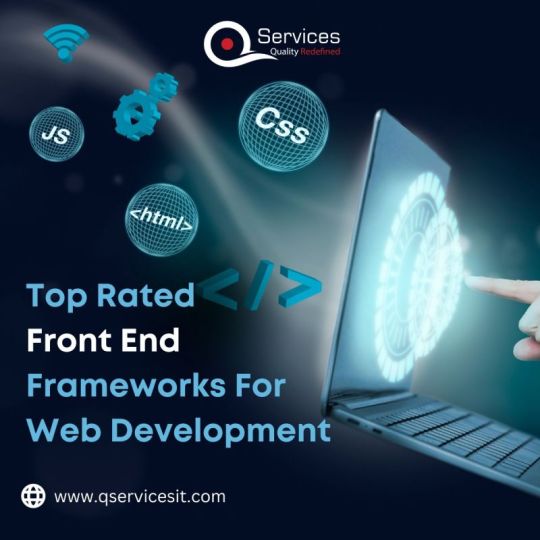
#frontend#frontenddevelopment#webdevelopment#webdeveloper#frontendframework#frontenddeveloper#QServices
1 note
·
View note
Photo
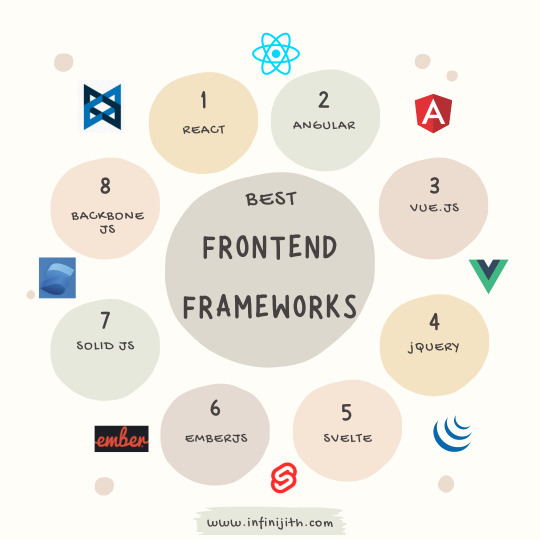
Best front end frameworks - Infinijith
Here are the 8 best frontend frameworks in 2022 that can help you developing the best web applications with better UI experience. Here is the list: Angular, React, Vuejs, Emberjs, Solidjs, Backbonejs, Svelte, and jQuery.
Want to hire front end developers in India for your project? Hire them from Infinijith and our developers will help you develop the best app. Visit us now! https://infinijith.com
0 notes
Text
0 notes
Text
Front End and Back End of website
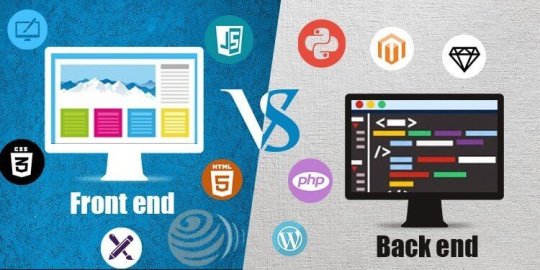
As we all know, the website is a collection of web pages. In each webpage there is a part which is visible to us on the display of computer mobile etc. and another part which contain some background processes, database and server. The first one which user interact is called the front end and the second mentioned above part is called the back end of the website.
Front end deal with the coding of the structure of website, its appearance or styling and the layout i.e. which item should be where on the display. The languages used in the front end are basically HTML, CSS and java script. HTML and CSS we have discussed in the previous blogs so now we are only discussing the java script. As HTML give structure and CSS give styling to the website, java script is used to add some advanced interactive features into the webpage like live video games, buttons, dropdown menus, animations, pop-ups, chat widgets etc. All these things take your website to the next level. Front end coders use frameworks and library like Bootstrap, JQuery, AngulerJS, EmberJS. Frameworks are used to ensure that the content appears on all the devices correctly and the libraries helps to code smarter and faster hence save time.
Back end of the website deal with the server side. It ensures the functionality of the website. The back end developers creates site’s operations, database and application programming interface(API). They do all these tasks using the server side programming language like Java(to add dynamics into website), Python( used to write data structure algoriths) and Ruby(used to build data server and data processing).
All the new and complex technical terms will be discussed in detail in the coming blogs.
0 notes
Text
What Exactly Is Web Development?
The process involved in creating a site for the Internet (World Wide Web) or internet is known as web development (a private network). Web development may include everything from designing a single static page of plain text to creating large web apps, electronic companies, and social network services.
Web engineering, Web design, Web content creation, client liaison, customer scripting, Web server, and network security settings, and e-commerce development are some of the more extensive jobs to which Web development typically refers.
"Web development" is commonly used among Web professionals to refer to the major non-design parts of constructing Web sites: authoring markup and coding. Content management systems (CMS) may be used in web development to make content modifications easier and more accessible to those with basic technical abilities. Read More..
Web development is strongly tied to the design of app features and functioning (web design). Typically, the phrase development refers to the actual building of these items (that is to say, the programming of sites). Web Development Styles
Front-end development, back-end development, and full-stack development are the three primary subtypes of web development.
Front-End Development: What Is It?
The "client-facing" portion of web development is covered by front-end development. In other words, front-end web development often refers to the area of a website, app, or digital product that people will view and interact with. Therefore, a front-end developer is in charge of how a digital product "feels," which is the reason they are frequently also known as web designers.
Front-End Web developers concentrate on converting visual concepts and website designs into code. A front-end software developer serves as a link between design and technology by implementing the design concepts developed by others in web development teams.
Programming languages like HTML, CSS, and JavaScript, as well as frameworks like React, Bootstrap, Backbone, AngularJS, and EmberJS, are often essential skills for front-end developers. A Front-End Developer's duties would include developing responsive websites (that look and work well on any device), doing website testing, resolving any issues found throughout the web development process, and making sure the site structure adheres to SEO best practices.
Back-End Development: What Is It?
Back-End Developers are concerned with how digital product functions whereas Front-End Developers are in charge of how it looks. A back-end developer builds the foundation of a website, containing database engagement, user authentication, server, network, hosting settings, and business logic, before maintaining it and making sure it functions as it should.
Back-end developers are focused on the mechanisms and frameworks that enable computer programs to function as intended while working behind the scenes, or "server-side."
Back-end developers' main duty is to guarantee the site's operation, along with its responsiveness and speed. Back-end developers must understand how to handle databases and data on a web server, as well as how to design servers using contemporary frameworks (while creating unique APIs and providing static webpages and files).
Back-end developers typically work with MySQL, Oracle, Git, and server-side programming languages like PHP, Ruby, and Python.
A Full-Stack Developer: What Is It?
An expert in both front-end and back-end programming is referred to as a full-stack developer. Since they are more versatile than developers who specialize, full Stack Developers frequently have access to a wide range of computer languages and may even be given greater leadership responsibilities on projects.
They are experts at carrying hats, generalists, and knowledgeable about every stage of growth. Full-Stack Developers are indeed the fourth-most in-demand career in the digital industry, so it goes without saying that organizations want to recruit them.
The generalist character of the role is the cause of any controversy around the designation. The idea that someone may be equally skilled at both jars developers who specialize in front-end or back-end development; the saying "jack of all trades, master of none" comes to mind.
0 notes